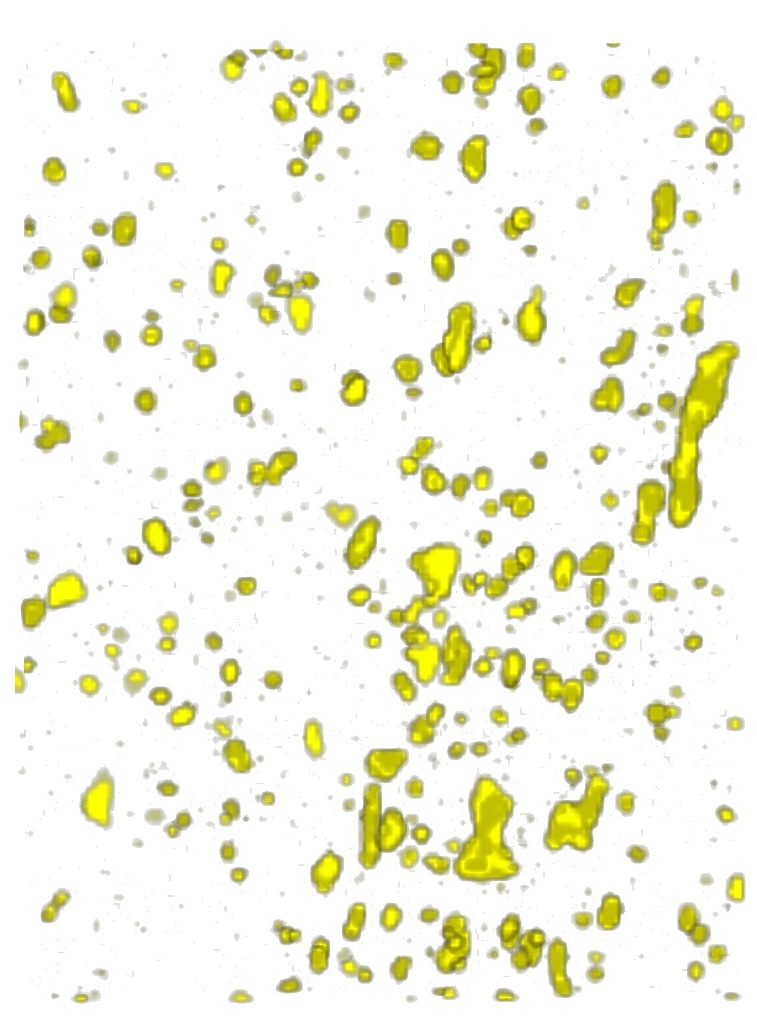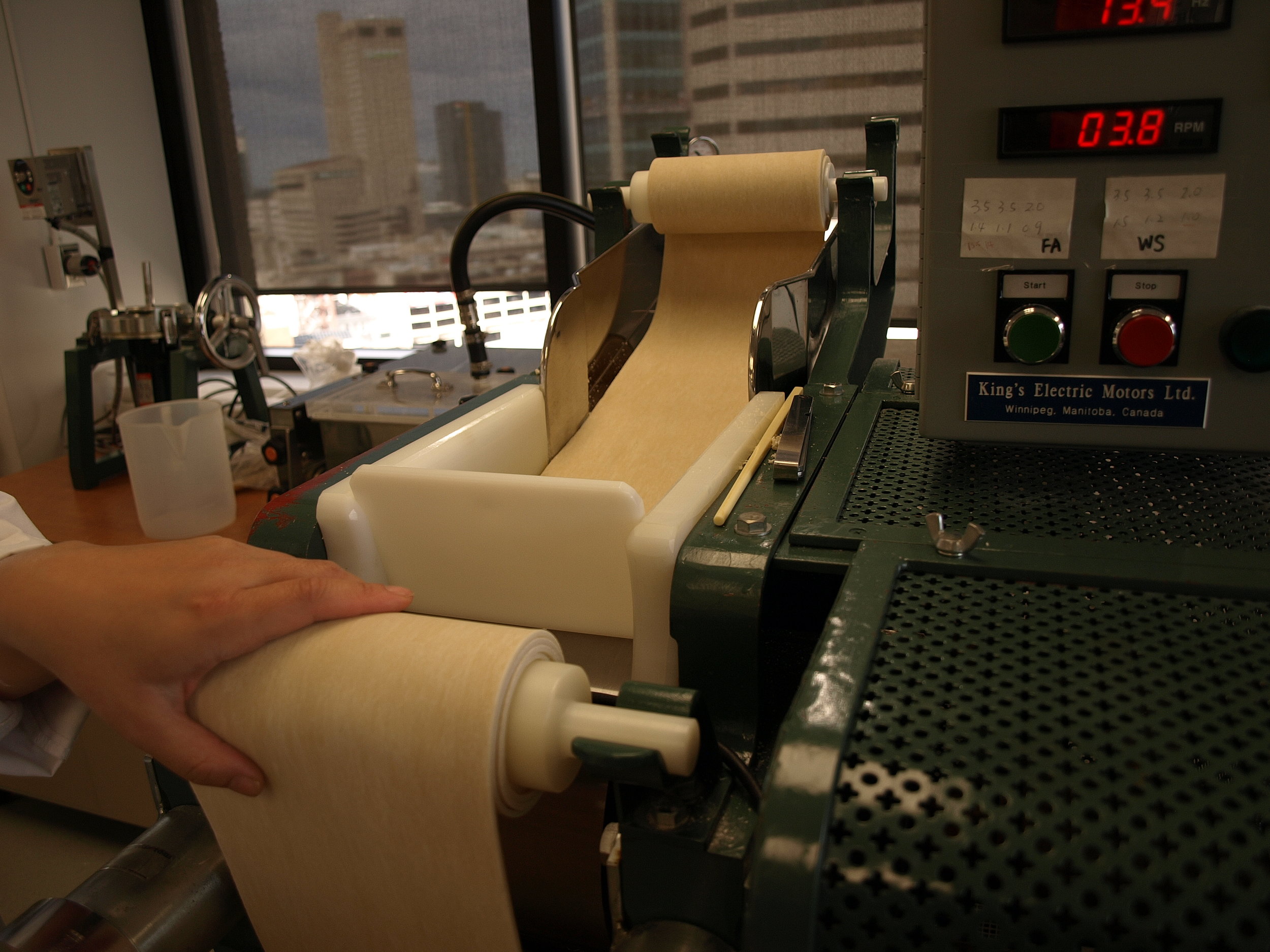Bubbles in noodle dough
A first look at how miniscule bubbles affect the texture of noodles
The texture of a noodle is a remarkably complicated thing. When you bite into a spoonful of ramen noodles, you expect a bit of springiness (or a resistance to your bite) on the outside and a pleasantly soft give on the interior. These variations are so tiny as to be often overlooked, but they matter to noodle quality.
Bubbles (in yellow) inside a noodle dough sheet.
Image courtesy of Reine-Marie Guillermic.
There are many factors in play in making a good noodle. For a wheat noodle, the structure of the gluten affects the overall quality. How a noodle dough is stretched, folded, and rolled out matters. And in between all of this, there are miniscule air bubbles that are part of the mix and influence texture.
Until recently, no one had ever looked at the bubbles in noodle dough.
“There was absolutely nothing in the literature indicating that the bubbles were there or that they were important at all. We did have some indirect evidence for bubbles from our ultrasonic experiments, but CLS microtomography was in some ways a hail Mary experiment: OK, let's just sheet some dough and see what we find,” said Martin Scanlon, U of M professor in the Faculty of Agriculture and Food Sciences, and the project’s lead researcher.
A cross-disciplinary U of M team came together to examine these phenomena, harnessing the CLS's ability to quickly acquire detailed 3D images of solid and soft materials at the micron scale. Scanlon and Filiz Koksel provided expertise in how food processing affects the properties of various foods, as well as experience using the CLS facility. Physics professor John Page and post-doctoral fellow Reine-Marie Guillermic lent their expertise in ultrasonics, an acoustic technique used to evaluate dough properties, and their expertise in modelling the influence of bubbles on the ultrasonic signals.
The team members took their dough to the BMIT beamline at the CLS, where they knew they would be able to get fast images with enough details to identify the bubbles as they evolved in the dough.
“Contrary to bread dough, noodle dough is much stiffer, and has many fewer bubbles – less than two per cent bubbles,” says Guillermic.
“It's something we haven't investigated very much yet, but from our CLS experiments it looks like you have regions where the bubbles cluster together,” says Guillermic.
Clusters of bubbles are likely to lead to cracks in the dough when it is dried for later sale, which is a problem for product quality.
L to R: Martin Scanlon, Xinyang Sun, Filiz Koksel and Reine-Marie Guillermic. Photo courtesy of the team.
Their research results, available online now, will be published in the March 2018 issue of Food Research International.
This is a noodle sheeter, used by the researchers to prepare their samples
Their imaging revealed bubbles at the scale of 20 micrometers, about a fifth of the thickness of a typical sheet of paper. The researchers expect that bubbles in a typical fresh dough would be even smaller, as their samples had already aged two days by the time they studied it.
“It’s quite surprising, you see a fast evolution in fresh dough when you do the acoustic measurements, which is why we suspect that bubbles in fresh dough are smaller still.”
Their results open up a rich line of inquiry into the fundamental chemistry and physics of these ubiquitous doughs.
“I don't think people have considered bubbles as an ingredient in noodle doughs before,” said Scanlon.
“We’ve also got bigger plans associated with fundamental modelling of how bubbles form and evolve in the dough, and some of the implications that might be relevant in terms of the quality of the product.”
The team plans to return to the CLS to take a closer look at how other properties—such as processing, water content, and gluten structure—interact with the fast-evolving bubble structure and the integrity of the final dough.
-30-
First published on lightsource.ca
Guillermic, R-M., F. Koksel, X. Sun, D. W. Hatcher, M. T. Nickerson, G. S. Belev, M. A. Webb, J. H. Page, and M. G. Scanlon. "Bubbles in noodle dough: Characterization by X-ray microtomography." Food Research International 105 (2018): 548-555. DOI: 10.1016/j.foodres.2017.11.050







